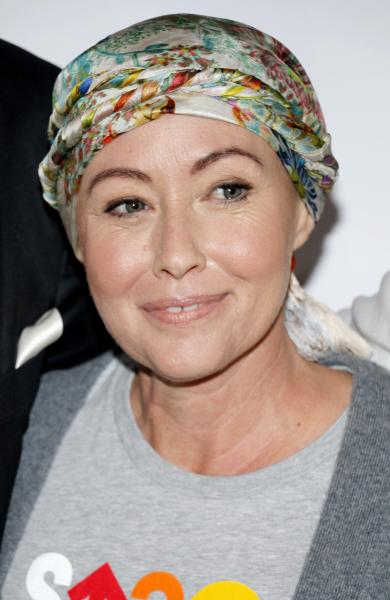Actress Shannen Doherty revealed in an Instagram message that she is in remission from breast cancer. In it, she eloquently articulated a very harsh reality for cancer patients about what remission does and does not mean.
As she indicated, the word “remission” does not mean she's in the clear. It is instead a hope that treatment and disease are about to become a closed chapter in the book of her life. She recognizes that before then it means five years of monitoring and surveillance and fluid emotions.
Being post-cancer means interwoven moments of reckoning and empowerment. Bursts of elation. Periods of waiting while worrying if the next visit to the doctor will mean more freedom or resurgence of disease. Moments of delivery of the latest news to anxious loved ones who were integrally and all-consumingly involved in your care. Moments of reminders of what you have been through and what could be around-the-corner.
It is quite common not to remove a patient’s port, implanted for chemotherapy delivery, immediately. Until then, it requires routine flushes by a medical professional. Its protuberance under the skin can be seen when standing in front of a mirror and can be felt when putting on a shirt. Such daily rituals can prompt fleeting moments of remembrance. This is but one example of continued reminders.
Shannen Doherty’s hashtag #cancerslayer is quite fitting. She is a cancer slayer. She will continue to be. Everyone who has survived cancer, and there are more each year, have 'slain the dragon.' She will now lead a new normal that all cancer survivors face, one that involves a shifting pendulum of fearlessness and fear, confidence and worry, relief and calm, uncertainty and certainty, unpredictability and predictability. Even predictable unpredictability.
Quite analogous to life—when we stop and realize the control we thought we had, in general, was merely a false perception. Enduring a cancer diagnosis and the subsequent clinical course amplifies this realization and its understanding. For many, it is freeing. For others, frustrating. Or both.
For many, liberation and perspective come with this invigorating designation of being “in remission.” Intolerance for petty exchanges and wasting time with activities or people you don't enjoy is a common development. Personality and world view are crucial to an individual’s life and well-being after hearing that precious word “remission.” It determines how a person manages the frequent follow-ups and scans.
Remission is really just the beginning of some new small steps. The path is marked by continued “all clear(s)” so those in remission can advance to every six months then possibly once a year. Gratitude becomes a gift, the cycle of surveillance an embedded part of your schedule. It is only with the passage of time, and those continuing “no cancer—all clear” doctor visits, that remission takes on the new meaning that those without cancer believe it has.
Depending on the type of cancer and stage of one’s illness, rates of recurrence can vary significantly and a high level of vigilance may become the mainstay of management. Often it entails imaging studies every three months with physician follow-up and blood work. So, the needles, intravenous contrast and hours spent to acquire such data serve as markers of the passage of time and place an exclamation point on the significance of that day’s endeavors.
Because of such frequency, the tiniest speck on the imaging modality of a known cancer survivor often leads to innumerable false starts. Blips on CT Scans get incredible attention. Biopsies and adjunctive testing routinely take place as a result of the intensity of the reviews. New worries arise and, hopefully, new relief. Renewed waiting for results, so that one can do just what Doherty proclaims “just breathe.”
Life goes on and relief flourishes after being told “remission.” Then, a few months go by and the next appointment is on the horizon. The cycle repeats.
With each disclosure of no spread or no recurrence, survivors can breathe a little. Be buoyed. Be liberated. Hence, the chronic nature of a new disease called “cautious optimism” or “watchful waiting.” The anxiety can be suffocating at times. The let downs and elation tiresome in their totality.
Doherty recognizes that is the burden and triumph of chronic disease. It is a marathon not a sprint. So, words like “slayer” and “warrior” and “champion” seek to do justice to the battles individuals endure and the extraordinary resilience of the human spirit and condition, even if they send an overly optimistic to the public who aren't sure what remission really means.
Thanks to medical innovation, once devastating prognoses are now survivable and even relegated to the arena of chronic disease. More people than ever are standing on the corpse of their dragon. We are living a period of significant advances, where in many instances cures and remissions are no longer a rarity.
Hope abounds today.
I applaud Shannen Doherty’s efforts to raise awareness by so publicly disclosing her story. The countless lives she will touch and positively influence will be immeasurable. Utilizing such a platform to help others is genuinely inspiring and can be channeled by so many in Hollywood to shift the paradigm of discovery. The power of such messages to move needles with respect to medical cures and research cannot be understated, see here.
To understand further the importance of such an impetus to strive for cures of chronic disease, please review the following articles: The Many Invisible Faces of Type 1 Diabetes, Men and Prostate Cancer: Fact Vs. Fiction, Did Gene Therapy Cure Sickle Cell Disease?, Dr. Jamie Wells on Al Jazeera TV Discussing Sickle Cell Anemia, Did Pompe Disease Get A New Champion In President Trump?, Pompe Disease, Newborn Screening And Inborn Errors Of Metabolism.





